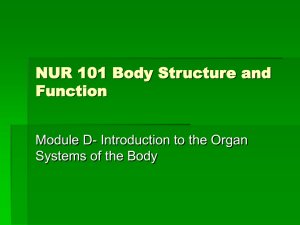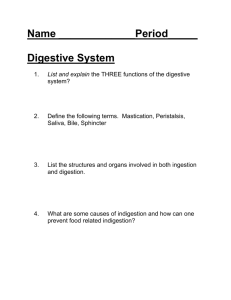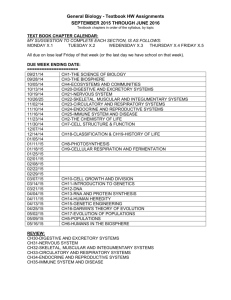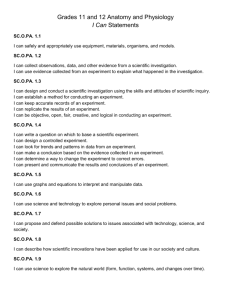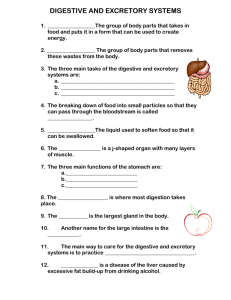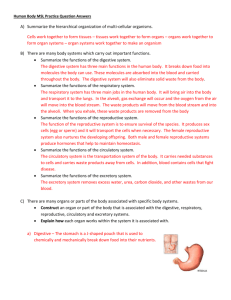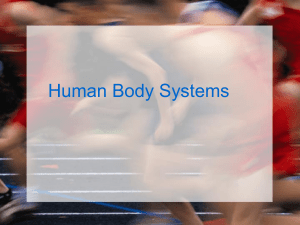Human Body Systems
advertisement
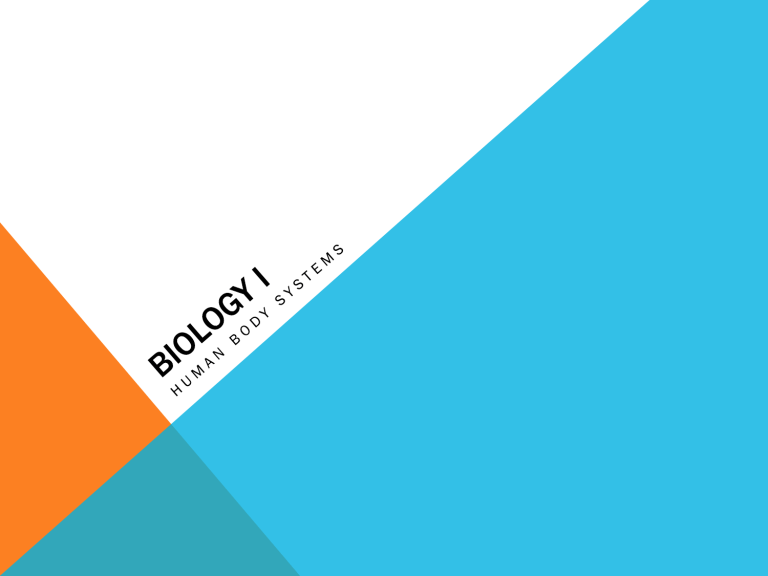
INTEREST GRABBER – NOTEBOOK #1 AN IMPORTANT PROCESS While walking along a dusty path, you begin to cough. As you continue your walk, a small insect comes flying toward you. You blink and then duck so that it misses you. These actions are just a few examples of homeostasis. Homeostasis is the process by which organisms keep internal conditions relatively constant despite changes in their external environments. 1. List three other examples of homeostasis that occur in organisms. 2. Why is homeostasis important to an organism? INTEREST GRABBER 1. List three other examples of homeostasis that occur in organisms. Accept all reasonable student examples that show an understanding of homeostasis. 2. Why is homeostasis important to an organism? Homeostasis allows an organism to remain in balance with its environment. If homeostasis is not maintained, it can harm the organism or result in the death of the organism. LEVELS OF ORGANIZATION IN A MULTICELLULAR ORGANISM Cell Tissue Organ Organ system Complete organism NERVOUS SYSTEM - controls and coordinates functions throughout the body and responds to internal and external stimuli Nervous System Integumentary System Skeletal System Muscular System Circulatory System NERVOUS SYSTEM Structures: Brain, spinal cord, peripheral nerves Function: Recognizes and coordinates the body’s response to changes in the internal and external environments NERVOUS SYSTEM - THE SYNAPSE Direction of Impulse -chemical messages (neurotransmitters) are sent to the synapse Dendrite of adjacent neuron Axon Vesicle Receptor Axon terminal Synaptic cleft Neurotransmitter THE BRAIN- left side of the body is controlled by the right side of the brain and the right side of the body is controlled by the left side of the brain Cerebrum Thalamus Pineal gland Hypothalamus Cerebellum Pituitary gland Pons Medulla oblongata Spinal cord INTEGUMENTARY SYSTEM – serves as a barrier against infection and injury (skin.) Nervous System Integumentary System Skeletal System Muscular System Circulatory System INTEGUMENTARY SYSTEM Helps regulate body temperature, removes waste products from the body, and provides protection from the radiation from the sun. INTEGUMENTARY SYSTEM SKELETAL SYSTEM – supports the body, protects internal organs, provides for movement, stores mineral reserves. 206 Bones in the human body. Nervous System Integumentary System Skeletal System Muscular System Circulatory System SKELETAL SYSTEM – site for blood formation SKELETAL SYSTEM – BONE STRUCTURE NOTEBOOK #2 1. What are the levels of organization in the human body? 2. What is the job of the nervous system? 3. What is a neurotransmitter? 4. What is the synapse? 5. What is the integumentary system? 6. What are some of the jobs of the integumentary system? 7. What is the job of the skeletal system? 8. What important tissue is manufactured in the bone marrow? MUSCULAR SYSTEM – three types of muscle tissue allow for movement in the body Nervous System Integumentary System Skeletal System Muscular System Circulatory System MUSCULAR SYSTEM Cardiac – found only in the heart Skeletal – usually attached to bone, responsible for voluntary movement Smooth – usually involuntary, found in internal organs (ex. Digestive tract) MUSCULAR SYSTEM – MUSCLE TISSUE CIRCULATORY SYSTEM – consists of the heart and a series of blood vessels Nervous System Integumentary System Skeletal System Muscular System Circulatory System CIRCULATORY SYSTEM • Arteries carry blood AWAY from the heart (oxygenated.) • Veins carry blood TO the heart (deoxygenated.) CIRCULATORY SYSTEM • Arteries have a pulse and are under great pressure. • Veins have valves to stop the back-flow of blood. CIRCULATORY SYSTEM INTERESTING FACT Red blood cells have no nucleus, so they have no DNA. How can DNA tests be performed on a blood sample? When a DNA laboratory receives a sample of blood in a test tube, the sample is put in a centrifuge to spin to separate the red cells from the rest of the blood. The DNA is extracted from the fraction containing the white blood cells. RESPIRATORY SYSTEM – brings the exchange of oxygen and carbon dioxide between the blood, air, and tissues Respiratory System Endocrine System Digestive System Reproductive System Excretory System Lymphatic/Immune Systems RESPIRATORY SYSTEM Larynx – contains vocal cords – found at the top of the trachea Trachea – windpipe Bronchi – lead to the lungs Alveoli – tiny air sacs, allow gas exchange Diaphragm – flat muscle that pulls air into the lungs RESPIRATORY SYSTEM NOTEBOOK #3 1. What are the three kinds of muscle tissue? 2. Where do you find cardiac muscle? 3. Where do you find skeletal muscle? 4. Where do you find smooth muscle? 5. What organelle is found in large numbers in muscle tissue? 6. What organs make up the circulatory system? 7. What is the difference between veins and arteries? 8. What is the job of the respiratory system? 9. What is the job of the alveoli? 10.What is the job of the diaphragm? DIGESTIVE SYSTEM – helps convert foods into simpler molecules that can be absorbed and used by the cells of the body Respiratory System Endocrine System Digestive System Reproductive System Excretory System Lymphatic/Immune Systems DIGESTIVE SYSTEM • Includes the mouth, pharynx, esophagus, stomach, and small intestine • Accessory organs include the salivary glands, the pancreas and the liver DIGESTIVE SYSTEM DIGESTIVE SYSTEM Peristalsis – food travels down the esophagus by a rhythmic contraction of smooth muscle EXCRETORY SYSTEM – eliminates waste products from the body in ways that maintain homeostasis Respiratory System Endocrine System Digestive System Reproductive System Excretory System Lymphatic/Immune Systems EXCRETORY SYSTEM • Includes the skin, lungs, kidneys, ureters, urinary bladder and urethra EXCRETORY SYSTEM ENDOCRINE SYSTEM – controls growth development and metabolism; maintains homeostasis Respiratory System Endocrine System Digestive System Reproductive System Excretory System Lymphatic/Immune Systems ENDOCRINE SYSTEM • Includes the hypothalamus, pituitary gland, thyroid, parathyroids, adrenals, pancreas, ovaries, and testes ENDOCRINE SYSTEM ENDOCRINE SYSTEM NOTEBOOK #4 1. What is the job of the digestive system? 2. Name several organs in the digestive system. 3. What is peristalsis? 4. What is the job of the excretory system? 5. What are some organs in the excretory system? 6. What is the job of the endocrine system? 7. Name some organs in the endocrine system? 8. Where is the pituitary gland found? REPRODUCTIVE SYSTEM –produces reproductive cells (egg and sperm) Respiratory System Endocrine System Digestive System Reproductive System Excretory System Lymphatic/Immune Systems REPRODUCTIVE SYSTEM • Includes the testes, epididymis, vas deferens, urethra, penis, ovaries, fallopian tubes, uterus, and vagina REPRODUCTIVE SYSTEM - MALE REPRODUCTIVE SYSTEM - FEMALE REPRODUCTIVE SYSTEM - PLACENTA • connects the fetus to the uterine wall to allow for nutrient uptake, waste elimination and gas exchange via the mothers blood supply. LYMPHATIC/IMMUNE SYSTEM – helps protect the body from disease; collects fluid lost from blood vessels and returns the fluid to the circulatory system Respiratory System Endocrine System Digestive System Reproductive System Excretory System Lymphatic/Immune Systems LYMPHATIC/IMMUNE SYSTEM • Includes the white blood cells, thymus, spleen, lymph nodes, lymph vessels LYMPHATIC/IMMUNE SYSTEM LYMPHATIC/IMMUNE SYSTEM Spleen- removes old red blood cells, stores blood, and recycles iron NOTEBOOK #5 1.What is the job of the reproductive system? 2.What are some of the organs of the reproductive system? 3.What is the job of the placenta? 4.What is the lymphatic/immune system? 5.What are some organs of the lymphatic/ immune system? 6.What is the job of the spleen?

